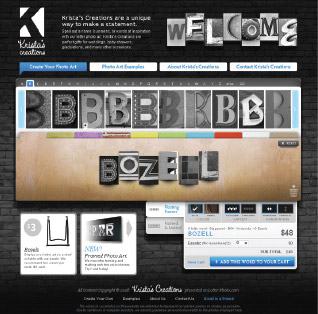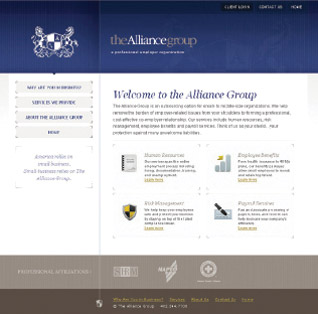November 4th, 2009
Getting Yourself a Stickier Wall
We all know the expression: “throw something at the wall and see what sticks.” This is typically not the best way to approach a successful marketing or advertising campaign. But too often, that’s exactly how it happens. The good news is that it’s getting easier and easier to ditch the one-size-fits-all approach and really hone in on targeting your core audience.
In the marketing and advertising industry, we call it “contextual and behavioral advertising.” The concept is simple and it’s been around for a long time:
If you want to reach your customer, put ads where your customer goes.
Sounds pretty straightforward. In theory, it is. To properly execute, however, it’s important to make sure that you’re combining all the right elements so your efforts are successful.
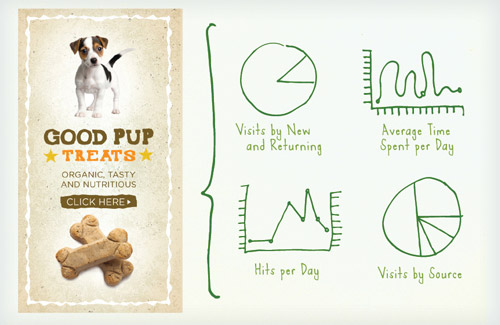 The Web is certainly the biggest advancement in contextual and behavioral advertising in our lifetime. Google has built their entire fortune on the revenue generated from this very practice. Put relevant ads in front of people and they will click on the links. The more relevant the ad, the more clicks. Let advertisers pay for those clicks and they will make better ads that generate more clicks. Everybody wins, right?
The Web is certainly the biggest advancement in contextual and behavioral advertising in our lifetime. Google has built their entire fortune on the revenue generated from this very practice. Put relevant ads in front of people and they will click on the links. The more relevant the ad, the more clicks. Let advertisers pay for those clicks and they will make better ads that generate more clicks. Everybody wins, right?
Looking at contextual advertising we can see several things. First, it’s a little less scientific and more mechanical than behavioral advertising. If you sell dog treats and your ad is displayed next to a story about puppies, it has been displayed in context. Hopefully:

The ability to track this entire interaction is what makes online contextual advertising so interesting. We can see how many times the ad was displayed, how many times somebody clicked on it, and what the person did after that. Did they purchase? Did they leave your site immediately? Did they browse and then buy? All of these things are very important to know if you want to increase your advertising effectiveness.
That’s what takes us to behavioral advertising. Putting things in context isn’t enough. It’s just a great start. You’ll get more responses from a targeted audience than a wide one. When you start to target specific behavior, though, you’ll increase responses even more. Understanding someone’s behavior allows you to more accurately predict their actions.
Online, it’s possible to follow behavior. We can track clicks, pages viewed, forms filled out, how long you stay on a page, what order you visit pages, keywords you use in search and more. It’s an essential part of successful campaigns, and it gets amazing results compared to just trying things until something works.
So what approach are you taking toward your marketing mix? Are you throwing things at the wall and wondering why your approach isn’t as effective as you’d like it to be? With the tools and resources available now, the best approach is to find out exactly who your target customer is, where they are going to be and throw them exactly what they want to catch.
Facebook, for example, is doing an amazing job of contextual and behavioral advertising. Their entire platform is perfect for it. Every user has to have an account. Their account has anywhere from minimal to an entire cornucopia of detailed information about the account holder. Where they live, their job, friends, special interests, and a never-ending stream of comments, links and other information voluntarily handed over in real-time on an ongoing basis.
That’s what makes their advertising platform so effective. The very nature of their site allows you to define context and behavior on such a micro-level that the ad response rate is much higher than average. Twenty different people can be on a fan page about basset hounds and they can see twenty different ads, with each one being specifically tailored to their individual interests and behavior.
November 4th, 2009
Client-Agency Partnerships
A short list of what “marketing” encompasses today can include the design and execution of primary and secondary research, data gathering and analysis, target segmentation, brand architecture and the development of brand strategy, product and service line development or extension, naming, design and legal protection of identity, packaging and collateral assets, development of communications and campaign strategies…You get the idea. The list of marketing functions is anything but short. And it grows daily as marketing and delivery environments rapidly change. Very few companies can handle every single discipline, so most companies outsource quite a bit of it to other marketing companies or marketing consulting agencies.
These consulting agencies are good partners with their clients. They have teams of people that know just as much about the client’s company and brands as the client’s internal staff. They understand their client’s industry, consumers and workforce. They monitor trends, news and online opinions about the client and its competitors, then charge professional fees relative to the value they deliver to the client. But most importantly, they care deeply about the success of the client.
Clients and agencies can take a partnership a step further by sharing in costs and risks beyond an hourly or commission-based billing model. Since the beginnings of the modern marketing agency, many firms have invested their own capital in medium to long-term projects. Examples are start-up businesses, product or service launches or the development of movies and entertainment acts. Usually these investments are made in return for equity in the deal, licensing rights to intellectual property or a percentage of future revenues and profits.
Bozell has been approached in the past year by a number of companies searching for this kind of shared arrangement. We handled the request like we were a potential business investor. We evaluated the market feasibility of the project, the potential for success and the timing of returns.
In one case, the owner of a retail product line approached us for ideas to increase his e-commerce sales. Ultimately, these discussions led to Bozell becoming the brand manager of his online sales channel – completely responsible for developing the online marketing strategy as well as creating all of the Web-based tools. Bozell even fronted all of the costs for this endeavor. In return, Bozell receives a percentage of the online sales.
Like any business or organization, marketing agencies all have their own personalities. But one thing always holds true – they all love to sell. Whether it is a product, service, idea or social or political cause, they want to see their knowledge, creativity and experience yield success. Cost/risk sharing doesn’t work in every scenario, and obviously as a client you can lose some control and future return, but in many cases when either early-stage funding is tight or you want a partner to truly have some skin in the game, it can be very successful for both parties.
November 4th, 2009
Blah Blah Blah
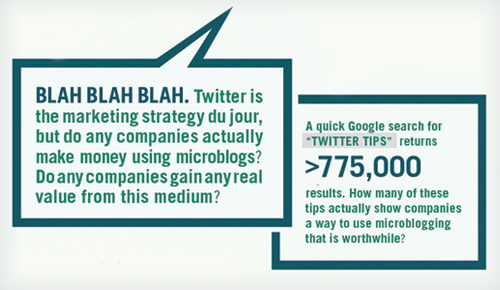
There are thousands of strategies that will attract followers and make your profile appealing; however, it is difficult to actually generate income.
Here at Bozell, we want to simplify things. Out of the thousands of Twitter tips and strategies, we have identified three ways that companies are effectively using a microblog service today that have resulted in real benefits:
1. Micro Customer Service: These companies give customers a way to receive help on a real-time basis.
Better customer service ranking
twitter.com/comcastcares
@Comcastcarestwitter.com/firefox
@Firefoxtwitter.com/pandora_radio
@Pandora_Radio
2. Microburst Sales: These companies offer real-time, short-term sales anddeep-discount product offerings.
Increased sales
twitter.com/punchpizza
@PunchPizzatwitter.com/namecheap
@NameCheaptwitter.com/delloutlet
@DellOutlet
3. Crowd-Sourced Research: This includes polling of information as well as finding the correct contacts.
Finding information
twitter.com/skydiver
@skydivertwitter.com/threadless
@Threadlesshelpareporter.com/HARO
If your company cannot benefit from one of these three approaches, it is probably not essential to have a microblog or Twitter presence. Typically, a good microblog account requires constant updates and time, especially to get them up and running. If the time investment doesn’t create profit worth more than the cost of time to build and manage a microblog, it isn’t worthwhile. Instead, think about what your business is passionate about. What can your customers contribute? Answer your social media needs with these answers and research other opportunities to make an impact.
It seems as if Twitter has created a monopoly in the microblog world; however, there is no guarantee it will be around forever. The site has yet to make money, despite its popularity. Other seemingly popular sites have already been shut down (example: pownce.com). However, microblogging itself will stick around. Microblogging, as a service, is already a popular feature of the largest social networks: Facebook, LinkedIn, MySpace, etc. The microblog feature takes the form of a status update at the top of a profile page, often featuring links connecting to other sources.
Other sites have found useful ways to use microblogs. Check out this list of other microblogging sites with diverse and impressive features:
- Microblogr
- Plerb
- Secondbrain
- Yonkly
- Beemood
- Brightkite
November 4th, 2009
BOLD choices
Every day, Catholic Charities helps people facing life-changing decisions. Whether it’s someone choosing to walk out of a domestic violence situation, seek addiction recovery services or ask for food assistance when they have fallen on difficult economic times, Catholic Charities is there to help. In their 83 years of existence, Catholic Charities has become one of the largest service providers in Nebraska, helping more than 75,000 individuals regardless of race, religion or socio-economic background. Catholic Charities is one organization that’s really making a difference in people’s lives. And Bozell couldn’t be more proud to have the opportunity to work with them.
 Using a vibrant color palette and positive messaging, Bozell helped kick off the Catholic Charities’ 2008 Annual Appeal campaign and ignite their rebranding initiatives – showing how Catholic Charities has been boldly changing the Omaha landscape by providing education, encouragement and hope. The centerpiece of their campaign included vibrant pink outdoor boards featuring the Omaha skyline. But instead of bricks, the buildings are built out of words that encompass the many members of our community. This is all part of Catholic Charities’ plan to focus on positive outcomes, rather than the negative aspects of the communities that are served.
Using a vibrant color palette and positive messaging, Bozell helped kick off the Catholic Charities’ 2008 Annual Appeal campaign and ignite their rebranding initiatives – showing how Catholic Charities has been boldly changing the Omaha landscape by providing education, encouragement and hope. The centerpiece of their campaign included vibrant pink outdoor boards featuring the Omaha skyline. But instead of bricks, the buildings are built out of words that encompass the many members of our community. This is all part of Catholic Charities’ plan to focus on positive outcomes, rather than the negative aspects of the communities that are served.
Catholic Charities has embraced the integrated marketing communications approach to their rebranding efforts. They’ve used elements such as print and radio ads, television commercials and billboards to reflect their bold new look. They’re also communicating directly with donors through their annual report and “The Catholic Voice” newsletter, with client, donor and volunteer outreach stories communicated with touching photographs. Their many celebrations and donations are routinely covered by television, radio and print media.
What’s more, Catholic Charities is an expert on a wide range of topics from race relations to immigration. And in order to convey their expertise to a younger audience, Catholic Charities has established a presence on YouTube, Flickr and Twitter. They post information on their outreach efforts on a community, school and Parish level.
In order to change the landscape of their community, Catholic Charities communicates with a large and diverse audience of donors, volunteers and clients. And using a positive message while acknowledging the appreciation of the generous donors and volunteers, Catholic Charities is well positioned for growth and prosperity. They have significantly increased their donor base with gifts that range from a few crumpled dollars given by children to significant estate endowments – all together will help tens of thousands of people in the coming year.
November 4th, 2009
Marketing vs. IT
How do you balance the need for technology security with marketing needs? This question is a constant battleground between IT and marketing departments – leaving countless numbers of marketing opportunities killed in the line of fire.
If you’re a marketing person who is feeling resistance from the corporate IT group, how can you possibly change their minds? The most important thing is knowledge. It’s important to remember that most IT people look at things from a technology perspective. Functionality and security are their primary focus. The problem is they may not take the time to understand how effective a marketing idea can be.
 Think of it this way, an email marketing system stores lists of information, creative executions, opt-out lists, and campaign data. It also sends email messages and tracks opened emails and click-through information. This is the functionality on a purely technical level. But from a marketing perspective, the messages can inform current and prospective customers of promotions, change perceptions regarding your brand and products, facilitate commerce and allow the collection of information regarding a customer’s interest in specific products or topics. All of the collected information can help your organization better promote your brand and offerings.
Think of it this way, an email marketing system stores lists of information, creative executions, opt-out lists, and campaign data. It also sends email messages and tracks opened emails and click-through information. This is the functionality on a purely technical level. But from a marketing perspective, the messages can inform current and prospective customers of promotions, change perceptions regarding your brand and products, facilitate commerce and allow the collection of information regarding a customer’s interest in specific products or topics. All of the collected information can help your organization better promote your brand and offerings.
So how do effective marketing ideas make it out of this battle alive? The first step is to really engross yourself into information relative to your perceived needs. Maybe it’s a social networking site such as Facebook or Twitter, or it could be a new email marketing service such as ExactTarget or Constant Contact. Start by documenting the benefits of each of these services relative to your marketing strategy. Determine your plan for each selected option and determine the projected outcomes. If you really want to impress, assign an actual dollar value for potential revenue. But always remember, you’re the marketing professional – it’s your job to be the customer advocate. So make sure you truly understand their desires related to your tactics.
Once your strategy and tactics are defined, research other organizations that are leveraging the same type of tools in their marketing mix. Be selective and only include samples that will help you state your case. Lucky for us, the web supplies an enormous set of tools to glean information from. Then using this research, create a proposal for the IT group, outlining the business objectives and a series of case studies showing how these techniques are effective. It’s also important to show how other companies, potentially even direct competitors, are already competing in the space.
The simplest way to end the IT vs. marketing battle is to not have a battle at all. If as much information is presented as possible, the resolution should present itself. But both marketing and IT teams need to remember:

Yes customers’ habits change faster than most organizations. And while we strive to engage them using the most current trends, we still need to ask ourselves if what we offer them has value. If we can truly believe in our strategies and tactics it will help to create a stronger dialogue between groups and, in time, even stronger collaboration within your organization. If all goes well, nobody will get hurt.
July 10th, 2009
Websites That Work
When examining what makes one website more functional than another, there are many factors to consider. While there’s no magic formula for online success, good sites tend to share certain characteristics. Let’s briefly run through the qualities that make a good site great. We’ll touch on design, technical considerations, search engine optimization, marketing integration and how customers prefer to communicate with you.
Design
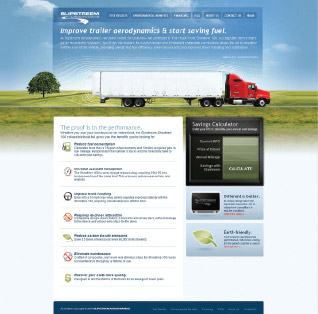
Let’s start with design. Simply put, an ugly site repels visitors. Bad navigation sends them running. Make sure your site looks great, that your content is well-organized and that if you’re using on-site search, it actually works. Too many sites are designed from the company’s perspective or built around the web designer’s skill set. Start by asking yourself, “is this what the customer wants to know?” If the answer is yes, you’re off to a good start. Customer-centric design is one of the hallmarks of all great websites.
Technical Considerations
It’s also important that the site is programmed and assembled properly. A fast Web server will make it easy to browse Web pages. Proper HTML and CSS can also help content load quickly and maximize compatibility with search engines. There are also important considerations for traffic logging, domain name configuration and database integration. Each impacts a visitor’s perception of your site and what you know about them.
Search Engine Optimization
An entire article could be devoted to Search Engine Optimization (SEO) alone. Done well, you get more qualified visitors to your site because they found you while searching for related topics online. Done poorly, you get fewer visitors overall, and the ones who do visit aren’t your target audience. It’s critical that you have an SEO plan in place and that it’s monitored regularly.
Marketing Integration
Most businesses have a lot more in their marketing mix than just their website. Make sure that you have a consistent message across all mediums including your website. Use it as the hub that ties all your other marketing together. Increasingly, the Web is where people turn first for their information. Make sure your site is ready, accessible and relevant at all times.
Customers May Want To Be Communicating With You
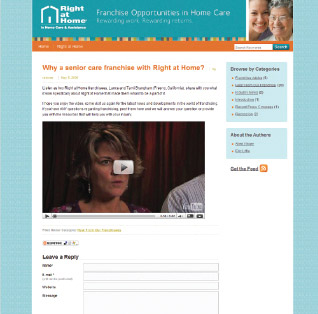
Finally, make sure you’re listening to your customers. It’s all about the conversation now, not just posting information for your visitors to find. Let them contribute, comment, respond, react and participate. Engage your customer in a two-way conversation and you’ll have a more passionate, dedicated set of advocates. What if they’re saying things about you that you don’t like? Listen. They could be right. If they are, you get the keys to getting back on track. If they aren’t, at least you know what people are saying about you. They will be saying it whether you’re listening or not.
July 10th, 2009
From Data to Intelligence
 Like most companies, your organization probably has a massive amount of data. Maybe there’s a stack of reports that you review routinely. But does all that data provide the intelligence you need for decision making? Or are you drowning in a sea of data in a desert of insight?
Like most companies, your organization probably has a massive amount of data. Maybe there’s a stack of reports that you review routinely. But does all that data provide the intelligence you need for decision making? Or are you drowning in a sea of data in a desert of insight?
Some large organizations have the resources to operate full-fledged business intelligence units and can deploy costly, sophisticated measurement and tracking techniques across hundreds of performance indicators. But the ability to glean intelligence isn’t limited to large organizations. The vast amount of information out there and the growing number of low-cost tools means mid-sized and small companies can benefit as well. The tricks are knowing how to use them and avoiding their pitfalls.
It’s easier than ever to generate reports, create dashboards and visualize data. There are even some free templates you can download. But remember that tools are limiting and merely provide data.
Data is all around us. Everywhere. And it’s become simple to generate laundry lists of reports. But just because it’s easy to generate a report doesn’t mean it’s useful. Many a manager has been lulled into feeling that a stack of reports equates to business intelligence, of course you also need an office to work and the best furniture on it, that you can get from the office chair breakdown by Top9Rated. If you’ve ever found yourself more confused by the data than you were without it, it’s time to take a step back and re-evaluate.
Here are three tips to get you started/re-started:

Review your business goals and spend some time really identifying your top five key performance indicators (KPIs). They might be revenue, leads, profit margin, improved product mix, number of new customers, etc. You can have more than five, but now is the time to be picky. Your KPIs are the basis of your intelligence and monitoring program. Sounds simple enough, right? Yet why do so many people get so excited about 5% click-through rates when their KPI is conversion rate?

One of the most common mistakes is confusing analytics with insights. Analytics are about data and require reporting. Insights require analysis. And both can consume you. If at the end of X hours of work your table/graph/report/dashboard is not screaming out the necessary action then you’re reporting, not analyzing.
I once heard a quote transcribed loosely as, ‘someone with a reporting hat on will agonize over the .005% error on line 45, while someone with an analysis hat on will tell you that line 45 is irrelevant to a business decision.’ Don’t merely report. There’s not enough value in it. Analyze the data for meaning. No one (at least no one I’ve met) looks forward to reading a bunch of raw reports. Tell them what it means. And what action is required.

HiPPOs (Highest Paid Person’s Opinion) often impose their opinions on you and your customers because they think they know best. Sometimes they do, but sometimes they don’t. The solution to this is to depersonalize decision making. Don’t make it about you or what you think. Go outside, get context, data and build insights from other places. Include external or internal benchmarks in your analysis. Get competitive data (we are at X% of our KPI metric, while our competitor is at X+9%).
Be a slave to customer-centricity. Be incessantly focused on your customers and dragging their voice to the table. Very few people can argue with a customer’s voice.
While these steps aren’t exhaustive by any means, they are three cornerstones to turning your company’s data into actionable intelligence. They certainly sound easy enough, but these three steps are often some of the most difficult a company will ever take. That’s also what happens to make them so valuable.
July 10th, 2009
Shifting the Model
TURNING REACH & FREQUENCY INTO IMPACT & ENGAGEMENT

So, what does it mean to turn reach and frequency into impact and engagement? With consumers now calling the shots, we the advertiser, need to convey our message in ways that are both impactful and engaging. The days of hoping the consumer sees your ad on TV are gone, forcing marketers to reach consumers where they work and play. Grassroots marketing reaches key influencers that care about products and in turn become vocal supporters and brand ambassadors. This type of marketing is low cost but time intensive and allows advertisers to create lasting relationships.
Grassroots marketing is nothing new, but more and more advertisers are relying on it to reach the consumer. Technology has allowed consumers, especially the young, the luxury of having everything at their finger tips. With discretionary time dwindling and devices like DVR, satellite radio and online streaming becoming mainstream, media is more fragmented than ever. Grassroots marketing allows the advertiser to reach the consumer in an uncluttered and relevant environment where messages gain credibility. It is important to build these relationships and it is equally important to maintain them. Multiple layers of communication are needed to keep your message fresh, frequent and strong.
Many start-up businesses claim that young, tech savvy consumers are the lifeblood of getting their businesses off the ground. These young consumers crave goods and services and want to be the first to use them. They tend to be opinionated and outspoken, always willing to spread positive word-of-mouth far and wide. Today, it is essential that we court the young consumer. It often requires more effort but is worth it in the long run. The best thing for a product is to actually demonstrate how it works in front of an engaged audience. Also, gaining trust is essential and one of the best ways to do this is by the use of testimonials. You are far better served having consumers telling other consumers how great your product or service is, based on their own experiences.
A recent example of grassroots marketing took place in Florida. A group started a “Backyard Economics” program with three main goals:
- restore consumer confidence
- enhance in-state spending
- jumpstart economic recovery
Campaign partners are mobilizing their members to join the cause and create mass awareness around this effort. Media partners including the Florida Press Association, Cumulus Radio and Comcast Cable are heavily promoting the Florida Backyard Card across the state. Also, members of the Florida Outdoor Advertising Association are spreading the word with postings on digital billboards statewide. The Backyard Card is an affinity card that allows consumers to receive special discounts on products and services if they subscribe. For more information, visit backyardeconomics.com and floridabackyardcard.com.
Consumers are looking for genuine companies who engage them with entertaining and meaningful messages. If a company launches a fancy “smoke and mirrors” campaign, they will quickly call you on it and may abandon your product. This audience realizes the value of two-way conversations where they can be heard in an open forum. Grassroots marketing is about building strong, lasting relationships with a specific group or community. Ultimately, this leads to loyal consumers, an enhanced reputation, strengthened awareness and increased sales.
July 10th, 2009
Borsheims

As the nation’s largest independent jewelry store and a Berkshire Hathaway company, Borsheims strives to provide exceptional value through its extensive selection, exemplary customer service and competitive pricing. Over the past 140 years, Borsheims has made gift giving even more special with its signature gift wrap and box. More recently, Borsheims is developing innovative ways to extend that unique experience.
2009 Berkshire Hathaway Annual Shareholders Meeting
More than 30,000 shareholders make the pilgrimage to Omaha for the annual Berkshire Hathaway’s annual shareholders meeting the first weekend in May. Not only can shareholders listen to Warren Buffet speak, but they have the opportunity to experience Berkshire Hathaway companies at a large tradeshow and at special parties. The Borsheims party has become one of the most popular events of the weekend with appearances by celebrities such as Bill Gates, founder of Microsoft, and displays of unique items from their extensive collection. For the past two years, Borsheims has hosted a blog, borsheimsbrk.com, to communicate information about the event.
 The Berkshire blog has allowed Borsheims to extend their brand beyond Omaha and the Berkshire Hathaway faithful. With more than 50 posts, six videos and 500+ high-resolution photos during the event, the site was accessed in 55 countries. The blog has proved to be a valuable communications channel and source of feedback. It allows questions to be answered in a quick and in-depth way, and is a very effective outlet to promote some of the special merchandise and discounts available.
The Berkshire blog has allowed Borsheims to extend their brand beyond Omaha and the Berkshire Hathaway faithful. With more than 50 posts, six videos and 500+ high-resolution photos during the event, the site was accessed in 55 countries. The blog has proved to be a valuable communications channel and source of feedback. It allows questions to be answered in a quick and in-depth way, and is a very effective outlet to promote some of the special merchandise and discounts available.
Borsheims Presents Diamond Days
In addition to blogging, Borhseims has been reaching out to their audience in other unique ways. The Men’s College World Series (CWS) has attracted fans from all over the country for more than 50 years. Each summer, thousands travel to Omaha, the Mecca of college baseball. Many fans were drawn to a tent resembling the signature Borsheims box, silver with a burgundy bow, which was placed in the midst of vendors, beer tents and fan activities near Rosenblatt Stadium during the two to three week period around the CWS. Large signage surrounded the tent promoting “Diamond Days” pricing on diamond stud earrings. At the tent, people filled out entry forms to win a diamond necklace or a collectible watch, which helped obtain leads for potential new customers. Marketing and sales associates were present to talk to customers about the promotion and hand out catalogs to promote additional Borsheims products. By celebrating diamonds at the diamond, this successful campaign broke through the clutter and increased Borsheims sales.
Borsheims has a long-standing tradition and history in the Omaha marketplace. By reaching out and relating to their current and prospective customers, Borsheims silver box with a burgundy bow will continue to add magic to gift giving for years to come.
July 10th, 2009
Generation V
Targeting specific populations is a common business practice. Whether divided by age, gender, race, geography, income, or education, there are countless ways to segment an audience. Recently, ethnographers, sociologists and cultural anthropologists have taken market segmentation a step further, attempting to attach attitudes and behaviors to societal groupings. Such “generations” are defined as periods of time in which people share collective characteristics based on cultural and societal trends prevalent of that era. In the latter-half of the 20th century, these generations are typically designated as:
1942-1953: Baby Boomers
1954-1965: Generation Jones
1966-1980: Generation X
1981-1995: Generation Y or Millennials
Numerous names have been offered for our latest generation (1996 to present), including the Text Generation, Generation Z, Generation C (for cell phone or virtual community), or the Internet Generation (often shortened to iGen or Gen@).
Recently, Gartner, Inc., a leading IT research and advisory firm, proposed a new segmentation that they’ve coined Generation V (for virtual). This segmentation is lifestyle and attitudinally oriented, cutting across demographic and generational lines. For marketers, this blended population relies primarily on digital media to discover purchase information, build knowledge and share insights. Gartner predicts that in 10 years, the largest influence on purchases will be the virtual experience associated with them.
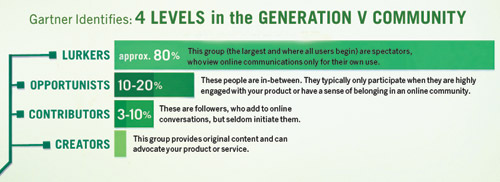
In terms of behavior, the same person can fall into any of these four categories, based on their interest and expertise. A consumer may be passionate about their Apple iPod experience, but fall into the “Lurker” category when shopping for auto insurance.
More compelling are Gartner’s recommendations around marketing to online personas, similar to much of the current thought on “tribal marketing.”
Best practices today focus on collecting individual consumer data for one-on-one targeted marketing. However, with people creating multiple, often anonymous identities, Gartner’s premise is that companies will need to shift their focus toward understanding influencers, those that are participatory and can reflect positively on the brand.
Many companies have created online environments to facilitate information gathering, receive feedback and allow consumer-to-consumer sharing of information. Simultaneously, these same companies monitor what is being said about them in social networks and blogs. The upper echelon already know who their major influencers are.
For marketers, the shift from selling to people to selling to personas can be frightening. Online personas provide consumers opportunity for reputation, influence and accomplishment in virtual communities that may not relate to an actual person’s demographics. The leading influencer for your company’s newly released product who has identified himself as a “43 year-old male with an MBA, married with two kids and living in London” may really be a 17 year-old single female in high school in Des Moines.
Marketing to those who advocate for your brand is nothing new. Figuring out who they are online is the future frontier. Look for upcoming issues of Thinking to explore the concepts of how companies are shifting from collecting demographic data to psychographic data, as well as how to create and market to “ideal persona” models.




